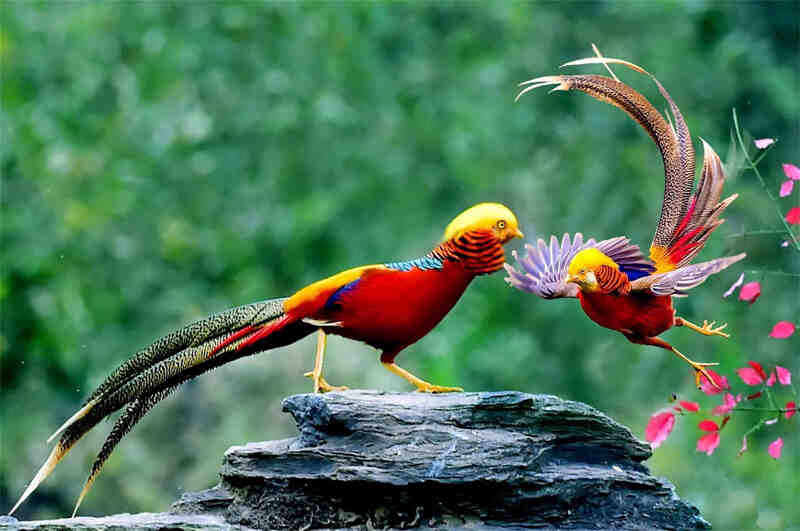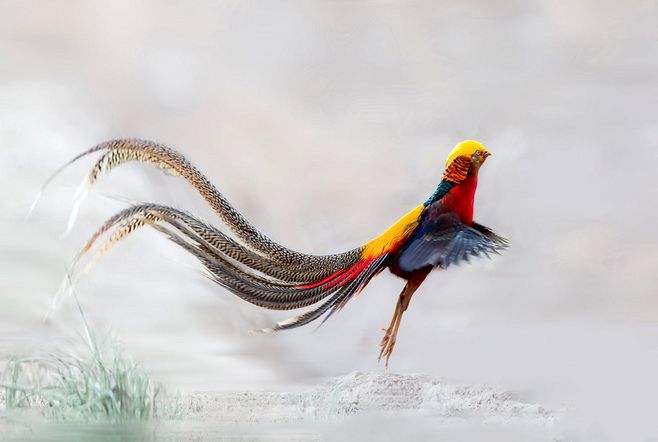Chrysolophus pictus
IUCN
LCBasic Information
Scientific classification
- name:Chrysolophus pictus
- Scientific Name:Chrysolophus pictus,Golden Pheasant,Golden pheasant, pheasant, pheasant, picker
- Outline:Landfowl
- Family:Gallinomorpha P.family Caragana
Vital signs
- length:59-107cm
- Weight:550-751g
- lifetime:About 20 years
Feature
Famous bird watching at home and abroad
Distribution and Habitat
Chinese specialty species, Distributed in the southeast of Qinghai, Gansu (Wenxian, Tianshui, Wushan), Qinling Mountains of Shaanxi, Sichuan (Qingchuan, Guangyuan, Beichuan, Pingwu, Nanjiang, Cangxi, Baoxing, Guanxian, Wushan, Xiushan, Nanchuan, MAO County), Chongqing (Wanzhou District, Chengkou, Wushan, Xiushan, Nanchuan, Wulong), western Hubei (Yunxian County, Xiangyang, Shennongjia, Yichang), Northeast Yunnan (Zhaotong, Weixin), Guizhou (Chishui, Zunyi, Suiyang, Jiangkou, Guiyang), Hunan Western and eastern Guangxi (He County, Gongcheng, Sanjiang, Tian 'e), Shanxi.
It lives in broad-leaved forest, mixed coniferous broad-leaved forest and open forest shrub area at an altitude of 500-2500 meters, and also appears in the undergrowth and bamboo area on the steep slope of the rock, and often goes to the grassy slope and cultivated land of the forest edge in winter.
Appearance
The male's forehead and crown feathers lengthen into filaments, forming a golden crown over the nape of the neck. The face, chin, throat and foreneck are rusty red, and the hindneck is surrounded by orange-brown fan-shaped feathers with blue-black feathers, forming a cape. The upper back is thick green, the feather margin is black; The lower back, waist and short tail are covered with deep golden yellow feathers, and the feathers are scattered like hair. From the waist onward on both sides, the tip of the feather turns dark red. The base of the upper cover of the long tail is cinnamon yellow, with black brown wavy twill, and the tip is long and narrow and deep red; 18 tail feathers, the central pair of tail feathers black brown, full of laurel yellow spots; Outer tail feathers laurel yellow with dark brown wavy twill; The outermost 3 pairs of tail feathers are dark chestnut brown, with dark brown twill. The shoulder feathers are dark red, and the innermost wing coverts and flight
Details
There are three subspecies of Golden Pheasant.

Red-belted chickens like to move in groups, especially in autumn and winter, sometimes as many as 30 in a cluster, spring and summer can also be seen alone or in pairs. Sex alert, timid. Hearing and visual sensitivity, a little sound, immediately flee, when the danger is still far away, more in the underground quickly run to flee; When the danger is approaching, more quickly fly up the tree. Good to run, on the way to meet low rocks or small open Spaces, then spread their wings and glide through. Flying is also very fast and dexterous, flying freely in the forest. During the day, most of them are active on the ground, especially in the morning and afternoon, rest in hiding places at noon, and live on trees such as pine and oak near gullies and hanging rocks at night. When climbing a tree, jump step by step from the lower branches, spiral up, or jump from the neighboring small trees. When night falls, you can often hear the "flutter, flutter, flutter" of the wings on the tree. They live more than 4 meters above the ground on the side branches of trees in the canopy. They usually live not in groups of one tree, but in several nearby trees.

It feeds mainly on the leaves, buds, flowers, fruits and seeds of wild pea, wild cherry, artemisia annua, fern leaf, wild garlic, raspberry, sora, rose, elaeagnus, sheep's milk, arrow bamboo, acorn, pine seeds, plum, sumac, cuckoo, brome, oak tree, Chinese chestnut and green okang. It also feeds on wheat, soybean, corn, green bean and other crops. They also eat animal foods such as beetles, worms, diptera and lepidoptera. Often walking in the forest while foraging, in the morning and evening also to the forest edge and farmland foraging.
When the male bird woos the female bird, it first walks to the female bird, while singing low, while running around the female bird and observe the color, when standing in front of the female bird, the male bird's gorgeous feathers are fluffy outward, and the colorful cape feathers cover the head, much like shaking open folding fan. The wings near the female bird are slightly lowered, and the other side of the wing is raised, and the colorful feathers on the wings, back and waist are displayed in front of the female bird, and the tail is also tilted over, making the beautiful tail feathers and the cover feathers on the tail appear very bright, and the eyes show love to the female bird. At this time, the female bird has been dazzled by the male bird's gorgeous feathers and a series of show-off movements, from time to time to let out a "sizzle" of envy.
The breeding period of red bellied chickens is from April to June. Polygyny, in which one male usually mates with 2-4 females. In late March, male birds began to seek mating behavior, and fierce fights often occurred between male birds and began to occupy areas. Male birds often call frequently in their territory, especially in the morning, often making monotonous' cha, cha, cha 'and' cha-chacha 'sounds. The nest is simple, only a shallow oval pit, padded with leaves, dead grass and feathers, the size of the nest is 16-23 cm in diameter ×16-17 cm, 6.5-10 cm deep. Each clutch lays 5-9 eggs, oval, light brown, smooth without spots, the size of the eggs measured by 14 eggs is 44.9 (41.0-51.4) mm ×32.9 (30.0-37.3) mm, weight 26.2 (24.4-27.3) grams. In captivity, 10 to 15 eggs were laid per litter with a size of (45) 44.2 (41.5-46.2) mm ×34.7 (31.0-36.8) mm and a weight of 26.7 (23.0-31.2) g. After the eggs are laid, the eggs are incubated, and the incubation period is 22 days in artificial feeding conditions.
A survey was conducted in Taibai and Pingli, Shaanxi, China in the autumn of 1982-1983, with an average density of 6.0 animals /km². In the fall of 1988, it was 3.0 /km²; The average density was 6.9 animals /km² in Beichuan, Sichuan Province from 1984 to 1985. In the autumn of 1984, the average density of Liupan Mountain in Ningxia was 3.6 birds /km².
In 2004, the State Forestry Administration of China issued the Guiding Opinions on Promoting the Sustainable Development of Wild Animals and Plants, which included the red-belted brocaded chicken in the list of land wild animals with mature domestication and breeding technology for commercial use. The wild animals in the list can legally enter restaurants and be put on the table after relevant procedures because their domestication and breeding technology has matured.
Listed in the "China Red Book of Endangered Animals" vulnerable.
Listed in the International Union for Conservation of Nature Red List of Threatened Species (IUCN) for 2016 ver 3.1 - Not Threatened (LC).
Listed in China's "National Key Protected Wildlife List" (February 5, 2021) Level 2.
Protect wild animals and eliminate wild meat.
Maintaining ecological balance is everyone's responsibility!








